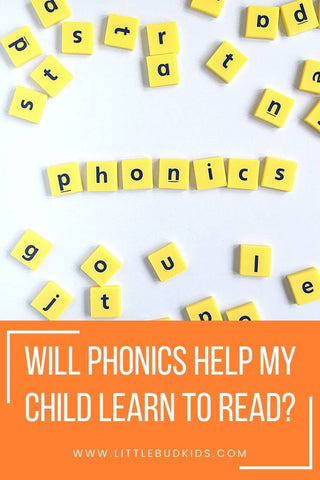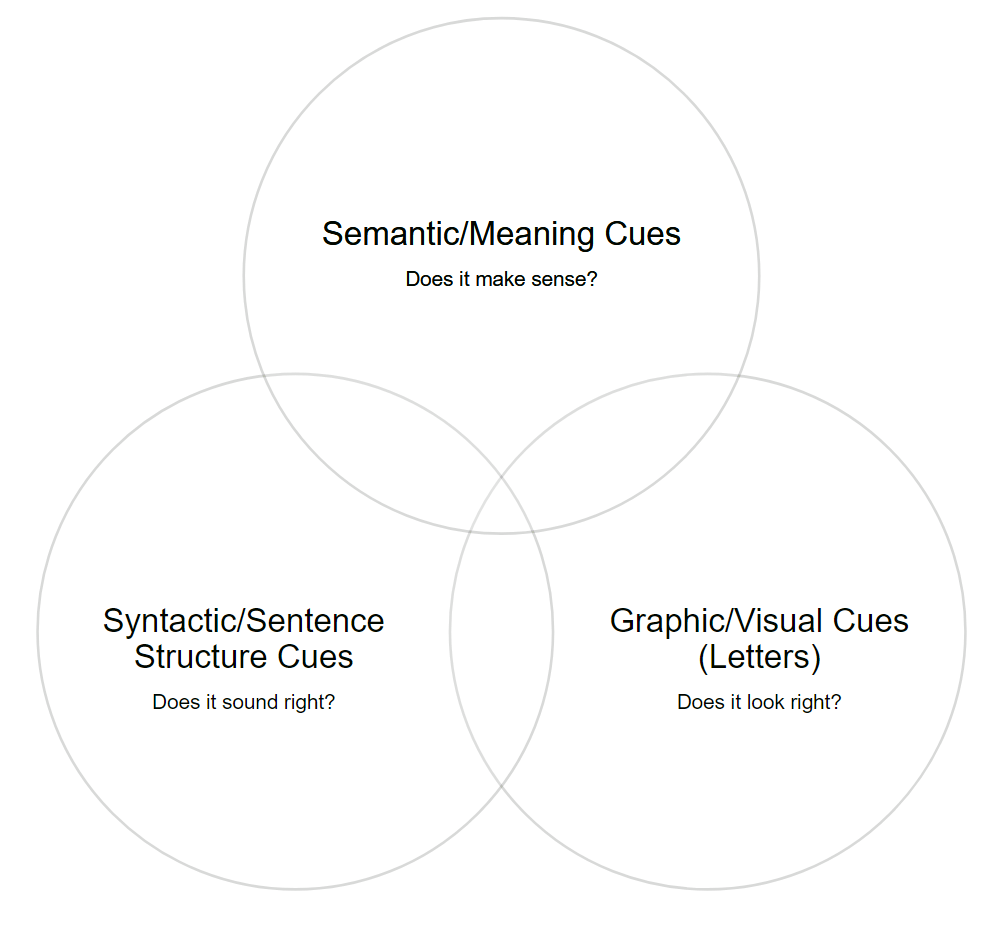Will Phonics Help My Child Learn to Read?
 Is providing a print-rich environment enough to help my child learn to read? Should I be actively teaching my child to read or letting them learn "naturally"? How do I even help teach? What is phonics? What about guided reading? These are all common questions parents have in figuring out how to help their child meet one of the greatest milestones of growing up. Perhaps before we dive into what you as a parent can do, a knowledge of reading science and the typical reading approaches used in schools today will help shed more light on how you can help your child.
Is providing a print-rich environment enough to help my child learn to read? Should I be actively teaching my child to read or letting them learn "naturally"? How do I even help teach? What is phonics? What about guided reading? These are all common questions parents have in figuring out how to help their child meet one of the greatest milestones of growing up. Perhaps before we dive into what you as a parent can do, a knowledge of reading science and the typical reading approaches used in schools today will help shed more light on how you can help your child.Reading is not a naturally-acquired ability like speaking is? Huh? Yes, you read that correctly. We don't just "pick up" on reading. Studies show that contrary to expected behavior, children cannot merely "absorb" how to read words by just being read to, shown words, or even being in a print-rich environment5 6. According to the National Assessment of Educational Progress's latest study in 2019, 65% of fourth graders in the U.S. are not proficient readers1. Studies further show that children who do not learn how to read by the end of third grade will likely have difficulty reading for the rest of their lives, and other academic areas will be impacted by this deficiency as well.

This statistic is alarming. So what is the issue? How do children actually learn to read? Is what we're teaching them effective? The ultimate goal of this article is not to provide a research paper on reading approaches that have resulted in a decades-long "reading war" between teachers, scientists, and practitioners. While reviewing the whole-word approach, all phonics, balanced literacy, structured literacy, 3-cue method, and 4-part processing method might be necessary for an educator (summarized nicely here and here), the takeaway from the scientific research is that phonetic instruction, or the knowledge of how to decode words, is fundamentally essential in establishing a strong grasp on the English language.
I know this not just because of research, but also from my own personal experience teaching English to ESL students. If students are unable to differentiate letter sounds and blend together those letters into words, then they will have a difficult time taking command over what they are "reading" and concurrently become discouraged by reading, spelling, and learning vocabulary.
So, you may be asking now, don't schools teach phonics? Well, yes and no. Despite numerous scientific studies that have long dismissed the belief that children learn to read by "absorbing" letters and words through exposure to written material, these studies are still struggling to make it into mainstream reading curriculum in the US 2 3 . The current approaches to reading instruction rely heavily on using a theory called three-cuing to predict what a word could be. The three cues include:

Ultimately, such a framework often sets up children to guess words relying on pictures or other clues. As an example, the below picture showcases repeated picture clues of bubbles and a girl with bubbles in her hair. This type of book guides readers to associate the word "bubbles" with the pictures of bubbles. According to this approach, even though readers might not know how to read "bubbles" exclusively, that is not what is important during this learning stage, and it would be considered a success if a beginner reader can successfully read this page with the help of the pictures.
If one were to isolate a word completely, children taught using this method would have a difficult time, well, reading it. Furthermore, relying on context and cues to read words ultimately results in children memorizing the "look" of a word. While schools are purportedly moving away from this reading approach, reports show that the focus on teaching to read is still largely based on the aforementioned concepts instead of on the knowledge of how a word's written marks or set of letters create a specific sound. That knowledge of how to decode words is based upon a framework that must be explicitly taught. And that framework is called phonics.
SO...tell me more about phonics and why is it important?
Phonics in a nutshell
According to phonics expert, Wiley Blevins 4
-
Shifts the focus away from picture or context clues
-
Establishes a well-rounded repertoire of strategies to draw from to read
-
To ultimately move a "beginner reader" to become a "fluent reader"
Approach:
So, in comparison with the "Bubbles, bubbles" excerpt above, taking a phonics approach to reading would be like the below:
Before being presented with this sentence, phonic learners would have had already learned the word family "-ar" and its corresponding sound. That learner would also have been taught how to blend the word family "-ar" with other letter sounds, thus completing the words Mark, shark, dark, and park. They would then effectively be able to apply their knowledge of the "-ar" word family and read words not in the text like far, yard, bark, etc... Learners would then go on to learn that while -ar has a distinct sound (defined as a phoneme), the word families -er, -ir, and -ur all make the same sound. Thus, they would be able to easily read and delineate that the word "car" has a distinct middle/ending phoneme compared to the words fern, sir, and bur, which all have the same middle/ending phoneme.
Execution:
It is easy to see how effective phonics instruction can be in equipping a beginner reader with a framework on how to grow his vocabulary bank, and ultimately reading fluency. A systematic approach to phonics first begins with teaching phonemic awareness - knowledge of the different individual sounds within a word - its beginning and ending sounds, how many sounds are in a word, how to blend together sounds, etc... After a child has mastered the letter sounds, he or she can then be introduced to the concept of the movable alphabet and how moving around letters and blending them together creates words.
Typically, simple three-letter CVC (consonant-vowel-consonant) words are the first step into introducing phonics to children; once they understand the framework of blending and decoding CVC words, they are then able to progress to decoding and reading more complex patterns and words. As shown in the diagram below, following a systematic approach to building upon advances in reading ability ultimately empowers and motivates a child in his reading journey, prompting him to forge towards reading fluency.

In conclusion, should you be helping your child learn to read? Absolutely. Should you be leaving reading instruction just to the schools? Absolutely not. As mentioned above, because it takes time for reading approaches to better accurately reflect reading science, chances are your child would probably thrive more with additional time spent on the fundamentals, something he or she may be getting very little of in a classroom.
But don't feel overwhelmed. The beauty of phonics is that it is slow-paced and made just for our little ones. It is not a magical reading formula, but it will sure make letters make a whole lot more sense than mere marks on a paper. It is not rocket science and neither is it guessing by picture cues, so starting to teach phonics can start as easily as reviewing the sounds of letters (not its name) and breaking down the different sounds within a word. Word families make tackling phonics straightforward, predictable, and fun. It brings up rhymes, a kid-favorite, and it brings up their creative juices - what kid doesn't like coming up with nonsense words when they go from "cat," manipulate the first letter, and come up with the word "jat"? And lastly, we are a big fan of our Spin-and-Read Phonetic Reading Blocks to jumpstart a child's journey into reading, so check it out here! We are also a huge proponent of having a good quality set of decodable phonics books in your home, and have found that Primary Phonics and the Emergent Reader Series excellent in helping children get a command on reading in a very systematic and empowering manner.

Children feel empowered knowing how to control the words they read, say, and write; reading does not become a subject matter where they merely get by and guess So, will phonics help my child learn to read? Maybe the question should be, how will it NOT help my child learn to read?
Itching to learn more about phonics? Click HERE to get our list of 20 Ways to Learn Phonics.
References:
1) NAEP Reading 2019 Highlights. http://www.nationsreportcard.gov/highlights/reading/2019/
2) Kids Struggle To Read When Schools Leave Phonics Out. Emily Hanford - https://hechingerreport.org/kids-struggle-to-read-when-schools-leave-phonics-out/
3) Gough, P. B., Hillinger, M. L. (1980). Learning to read: An unnatural act. Bulletin of the Orton Society, 30, 179–196.
4) Understanding Phonics. https://www.scholastic.com/teachers/articles/teaching-content/understanding-phonics/
5) Treiman, R. (2018). What Research Tells Us About Reading Instruction. Psychological Science in the Public Interest, 19(1), 1–4. https://doi.org/10.1177/1529100618772272
6) Why Reading Is Not a Natural Process. ASCD-http://www.ascd.org/publications/educational-leadership/mar98/vol55/num06/Why-Reading-Is-Not-a-Natural-Process.aspx




Leave a comment